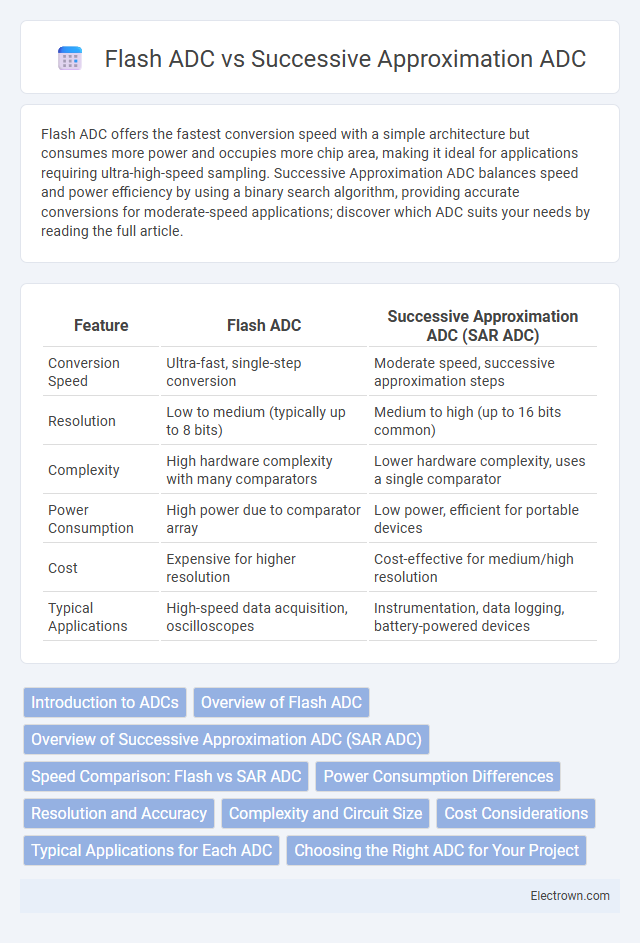Flash ADC offers the fastest conversion speed with a simple architecture but consumes more power and occupies more chip area, making it ideal for applications requiring ultra-high-speed sampling. Successive Approximation ADC balances speed and power efficiency by using a binary search algorithm, providing accurate conversions for moderate-speed applications; discover which ADC suits your needs by reading the full article.
Table of Comparison
| Feature | Flash ADC | Successive Approximation ADC (SAR ADC) |
|---|---|---|
| Conversion Speed | Ultra-fast, single-step conversion | Moderate speed, successive approximation steps |
| Resolution | Low to medium (typically up to 8 bits) | Medium to high (up to 16 bits common) |
| Complexity | High hardware complexity with many comparators | Lower hardware complexity, uses a single comparator |
| Power Consumption | High power due to comparator array | Low power, efficient for portable devices |
| Cost | Expensive for higher resolution | Cost-effective for medium/high resolution |
| Typical Applications | High-speed data acquisition, oscilloscopes | Instrumentation, data logging, battery-powered devices |
Introduction to ADCs
Analog-to-Digital Converters (ADCs) are essential components in digital signal processing, translating continuous analog signals into discrete digital values. Flash ADCs offer ultra-fast conversion speeds by using a parallel array of comparators but consume more power and chip area. Successive Approximation ADCs balance speed and complexity by iteratively refining the digital output, making them suitable for moderate-speed applications with lower power consumption.
Overview of Flash ADC
Flash ADC, also known as parallel ADC, converts analog signals to digital in a single step using a bank of comparators, allowing ultra-fast conversion speeds ideal for high-frequency applications such as radar and digital oscilloscopes. It typically features a resolution of 4 to 6 bits due to exponential growth in required comparators (2^n - 1), leading to increased power consumption and chip area, making it less practical for higher resolutions. Flash ADC excels in applications demanding minimal latency and maximum throughput, contrasting with slower but more power-efficient alternatives like Successive Approximation ADC.
Overview of Successive Approximation ADC (SAR ADC)
Successive Approximation ADC (SAR ADC) converts analog signals into digital by using a binary search algorithm with an internal DAC, enabling precise and power-efficient sampling. SAR ADCs excel in medium-speed and medium-resolution applications, typically offering resolutions from 8 to 16 bits with sampling rates up to a few megasamples per second. Compared to Flash ADCs, SAR ADCs provide better resolution and lower power consumption, making them ideal for embedded systems and portable devices requiring accurate data conversion without high-speed demands.
Speed Comparison: Flash vs SAR ADC
Flash ADC offers the highest conversion speed by using a parallel architecture with multiple comparators, typically achieving conversion times in the nanosecond range, making it ideal for ultra-high-speed applications. Successive Approximation Register (SAR) ADCs, though slower with conversion times in microseconds, provide a balance between speed, power consumption, and resolution, making them suitable for moderate-speed, high-accuracy measurements. Flash ADCs excel in speed but consume significantly more power and silicon area compared to SAR ADCs, which use a single comparator and binary search algorithm to achieve efficient, stepwise approximation.
Power Consumption Differences
Flash ADCs consume significantly more power than Successive Approximation ADCs due to their parallel architecture requiring multiple comparators operating simultaneously. Successive Approximation ADCs use fewer components and sequential processing, resulting in lower power consumption ideal for battery-powered and portable devices. Your choice depends on balancing speed demands with power efficiency requirements in your application.
Resolution and Accuracy
Flash ADCs provide ultra-fast conversion speeds but typically offer lower resolution, often limited to 4 to 6 bits, resulting in moderate accuracy due to comparator offset errors. Successive Approximation Register (SAR) ADCs achieve higher resolution, commonly ranging from 8 to 18 bits, delivering greater accuracy by performing bitwise approximation and minimizing quantization errors. While Flash ADCs excel in speed-sensitive applications, SAR ADCs are preferred for precise measurements requiring superior resolution and accuracy.
Complexity and Circuit Size
Flash ADCs exhibit high complexity and large circuit size due to their use of 2^n - 1 comparators for an n-bit resolution, making them impractical for resolutions beyond 8 bits. Successive Approximation ADCs significantly reduce complexity and circuit size by employing a single comparator and a digital-to-analog converter in a binary search algorithm, making them more suitable for medium-resolution applications. The simpler architecture of Successive Approximation ADCs enables lower power consumption and smaller chip area compared to the densely interconnected comparator array in Flash ADCs.
Cost Considerations
Flash ADCs generally incur higher costs due to their complex architecture comprising multiple comparators and extensive circuitry, making them less economical for high-resolution applications. Successive Approximation ADCs offer a more cost-effective solution by utilizing a binary search algorithm with fewer components, reducing both material and manufacturing expenses. Your choice should weigh budget constraints against performance needs, as Flash ADCs deliver faster conversions at a premium price, while SAR ADCs balance accuracy and affordability.
Typical Applications for Each ADC
Flash ADCs are ideal for ultra-high-speed applications such as radar systems, digital oscilloscopes, and high-frequency communication where rapid data conversion is crucial. Successive Approximation ADCs suit medium-speed, high-resolution needs found in industrial control systems, medical devices like ECGs, and data acquisition systems. Both ADC types optimize efficiency based on application speed and resolution demands.
Choosing the Right ADC for Your Project
Flash ADCs offer ultra-fast conversion speeds ideal for high-frequency signals but consume more power and have lower resolution compared to Successive Approximation ADCs (SAR). SAR ADCs provide a balanced trade-off with moderate speed, higher accuracy, and lower power consumption, making them suitable for precision measurement in embedded systems. When choosing the right ADC for your project, consider the signal frequency, resolution requirements, and power constraints to ensure optimal performance.
Flash ADC vs Successive Approximation ADC Infographic

 electrown.com
electrown.com